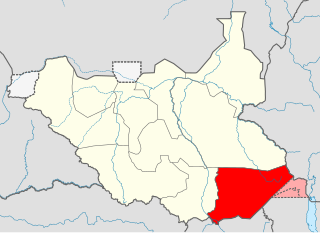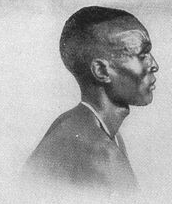
Equatoria is the southernmost region of South Sudan, along the upper reaches of the White Nile and the border between South Sudan and Uganda. Juba, the national capital and the largest city in South Sudan, is located in Equatoria. Originally a province of Anglo-Egyptian Sudan, it also contained most of northern parts of present-day Uganda, including Lake Albert and West Nile. It was an idealistic effort to create a model state in the interior of Africa that never consisted of more than a handful of adventurers and soldiers in isolated outposts.

Eastern Equatoria is a state in South Sudan. It has an area of 73,472 km2. The capital City is Torit. On October 1, 1972, the state was divided into Imatong and Namorunyang states and was re-established by a peace agreement signed on 22 February 2020.

The Dinka people are a Nilotic ethnic group native to South Sudan. The Dinka mostly live along the Nile, from Mangalla-Jonglei to Renk, in the region of Bahr el Ghazal, Upper Nile, and the Abyei Area of the Ngok Dinka in South Sudan.
The Kuku are a Nilotic tribe of the Karo people from South Sudan. They inhabit the agricultural lands of Kajo Keji County in Central Equatoria State. The Kuku speak a Kuku dialect, also called BaKuku.

The Toposa are a Nilotic ethnic group in South Sudan, living in the Greater Kapoeta region of Eastern Equatoria state. They have traditionally lived by herding cattle, sheep and goats, and in the past were involved in the ivory trade. They have a tradition of constant low-level warfare, usually cattle raids, against their neighbors.
The Ketebo people are an ethnic group in South Sudan. The Ketebo are inhabitants of Bira which is the land of the Ketebo. Bira which was a Ugandan Protectorate until 1925 and was transferred to Sudan's administration in 1926. The Ketebo are sometimes referred to by the Didinga as "Loceha/Loceka". The Ketebo live in Bira, which is one of the Payams of Kidepo County, Torit, Eastern Equatoria State of South Sudan. They are one of the smallest and least known tribes in South Sudan. The Ketebo in Uganda are called Mening, which is also one of the smallest tribes in Uganda. The population of this ethnic group is over 45,000. Bira is the land of the Ketebo which include; Lofus, Madial, Lorum, Lotome, Lojilingare, Arata, Nakoringole, Lonyili, Kamulach, Tulel, Ofi, Natedo, Nahitahapel (Ihapelmoru), Naurkori, Lochorangichokio, Lokudul, Napeyase, Ogeng, Tongoborei, Kalabe (Apoka), Irobi, Narus, Koryang, Tomoodo, Koryang, Losigiria, Irobi just to mention a few. The Ketebo people are also found in Lotukei in Budi County.
The Tennet people are South Sudanese. Their language is sometimes referred to as Ngaarit. Tennet traditional dances are divided into the following categories: Lalu, Nyaliliya, Loduk, and so on

The South Sudan People's Defence Forces (SSPDF), formerly the Sudan People's Liberation Army (SPLA), is the army of the Republic of South Sudan. The SPLA was founded as a guerrilla movement against the government of Sudan in 1983 and was a key participant of the Second Sudanese Civil War, led by John Garang. After Garang's death in 2005, Salva Kiir was named the SPLA's new Commander-in-Chief. As of 2010, the SPLA was divided into divisions of 10,000–14,000 soldiers.
The Nyangwara or Yangwara are a Nilotic ethnic group numbering between 25,000 and 30,000 people living in the South Sudan in the state of Central Equatoria. The word Yangwara means Horns. They live divided between Terekeka and Juba Districts. Their main town is Rokon, which lies about 53 miles west of Juba. Environment, Economy and Natural Resources Yangwara land enjoys tropical to rich savannah type of climate. It is endowed with deep fertile soil and is dissected by a number of perennial streams that drain into the river Nile. It receives rains between March and November enough to sustain extensive agricultural activities in the area.
The Lopit language is an Eastern Nilotic language spoken by around 117,000 people in Eastern Equatoria State, South Sudan. Lopit is part of the Lotuko-Teso subfamily and is related to Lotuko, Turkana and Maasai. Lopit is a VSO language and has a complex tonal system.

Nyau is a secret society of the Chewa, an ethnic group of the Bantu peoples from Central and Southern Africa. The Nyau society consists of initiated members of the Chewa people, forming the cosmology or indigenous religion of the people. Initiations are separate for men and for women, with different knowledge learned and with different ritual roles in the society according to gender and seniority. Only initiates are considered to be mature and members of the Nyau.
Ikotos County is an administrative area in the Eastern Equatoria state of South Sudan with headquarters in the town of Ikotos. The people, who live in the county's area by subsistence agriculture and cattle herding, are poverty-stricken. Years of civil war have made violence commonplace: most people have experienced the murder of a close family member. In 2009, AK-47 rifles were used in 42 per cent of killings.
Tirangore is a village in the Hiyala Payam of Torit County in the Eastern Equatoria State of South Sudan. It lies to the northeast of Torit.

South Sudan is home to around 60 indigenous ethnic groups and 80 linguistic partitions among a 2021 population of around 11 million. Historically, most ethnic groups were lacking in formal Western political institutions, with land held by the community and elders acting as problem solvers and adjudicators. Today, most ethnic groups still embrace a cattle culture in which livestock is the main measure of wealth and used for bride wealth.
Lafon is a county in Eastern Equatoria State of South Sudan. The largest town is Lafon.
Budi County is an administrative area of Eastern Equatoria state in South Sudan, with headquarters in Chukudum.
Riwoto is a community in Eastern Equatoria state of South Sudan. It is a payam and village in Kapoeta North County.

Kapoeta East County is an administrative region of Eastern Equatoria state in South Sudan, bordered by Kenya to the south, Ethiopia to the east and Jonglei state to the west. It is part of the Greater Kapoeta region of the state. The largest ethnic group is the Toposa people. The principal town is Narus. The county includes the disputed Ilemi triangle, controlled by Kenya. The emblem of the county is a horned bull, with big humps and a large tail.
Joseph Oduho Haworu was a leading politician from southern Sudan who was active in the struggle for independence and a founding member of the Sudan People's Liberation Movement (SPLM).
Mount Lado or Jebel Lado is an isolated hillock in Central Equatoria, South Sudan, about 13 km northwest of the White Nile and 28 km due north of the national capital Juba. The mountain was also called Mount Nyerkenyi.















